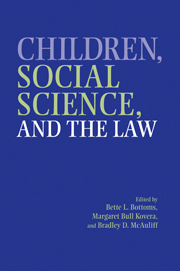Book contents
- Frontmatter
- Contents
- Acknowledgments
- Contributors
- 1 Children, Social Science, and the Law: An Introduction to the Issues
- PART I CHILDREN'S RIGHTS, THEIR CAPABILITIES, AND SOCIETY'S RESPONSIBILITIES TO CHILDREN
- 2 The Personal Responsibility and Work Opportunity Reconciliation Act of 1996: What Will It Mean for Children?
- 3 Advocacy for Children's Rights
- 4 Children's Rights and Capacities
- 5 Children's Legal Representation in Civil Litigation
- PART II CHILDREN AND FAMILY CHANGE
- PART III JUVENILE AGGRESSION AND JUVENILE JUSTICE
- PART IV CHILDREN AS VICTIMS AND WITNESSES
- PART V CONCLUSIONS AND FUTURE DIRECTIONS
- Author Index
- Case Index
- Subject Index
- References
4 - Children's Rights and Capacities
Published online by Cambridge University Press: 24 July 2009
- Frontmatter
- Contents
- Acknowledgments
- Contributors
- 1 Children, Social Science, and the Law: An Introduction to the Issues
- PART I CHILDREN'S RIGHTS, THEIR CAPABILITIES, AND SOCIETY'S RESPONSIBILITIES TO CHILDREN
- 2 The Personal Responsibility and Work Opportunity Reconciliation Act of 1996: What Will It Mean for Children?
- 3 Advocacy for Children's Rights
- 4 Children's Rights and Capacities
- 5 Children's Legal Representation in Civil Litigation
- PART II CHILDREN AND FAMILY CHANGE
- PART III JUVENILE AGGRESSION AND JUVENILE JUSTICE
- PART IV CHILDREN AS VICTIMS AND WITNESSES
- PART V CONCLUSIONS AND FUTURE DIRECTIONS
- Author Index
- Case Index
- Subject Index
- References
Summary
The notion that children possess rights is relatively recent in U.S. history. In the last 150 years, children's nurturance rights have been established, and some rights to self-determination for minors have also begun to emerge. The extension of certain rights to minors has raised a number of questions regarding their understanding of and capacity to exercise these rights in legally relevant contexts. In the last several decades, psychology has made important strides toward answering these questions. In this chapter, we first offer a historical context for the emergence of children's rights; then we outline five areas of the law that have witnessed significant change in recent years. Finally, we discuss social science research on children's understanding of the law and their rights, as well as children's competence to make legally relevant decisions.
A BRIEF HISTORICAL CONTEXT
For hundreds of years, children in the United States were valued mainly as economic assets in a largely agrarian society. It was not until the mid-1800s that children began to be valued sentimentally and recognized as requiring nurturance and protection (Hart, 1991; Walker, Brooks, & Wrightsman, 1999). To meet these needs, the family was given the responsibility as well as the autonomy to provide for the best interests of children (Chisholm, 1981; Reppucci & Crosby, 1993).
- Type
- Chapter
- Information
- Children, Social Science, and the Law , pp. 76 - 105Publisher: Cambridge University PressPrint publication year: 2002
References
- 3
- Cited by



